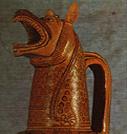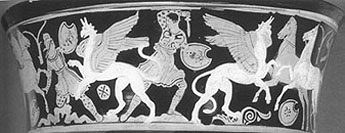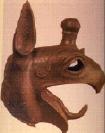Griffin



A monster devised by the Greeks after models from Near Eastern art. It has a lion's body, an eagle's neck and head (sometimes with a forehead knob and long ears) and wings. From the 5th century BC on it has a spiky mane. It was a popular decorative subject on its own, or attacking other animals. The monster was identified as the 'griffin' which guarded gold in the frozen north and was attacked by Arimasps, who are shown in classical art as easterners, often like Persians.
Griffins also accompany
Apollo (as a northern, Hyperborean deity), who rides them or has them pull his chariot. The neck and head was a popular decoration for bronze cauldrons in the 8th to 6th centuries BC.
Above left: Mouth of the griffin jug from Aigina painted on one of the Cycladic islands. London, British Museum 73.8-20.385. Photo courtesy the Trustees of the British Museum. © British Museum Licence Plate 11 UK 1007 148
Above middle: Detail from Athenian red-figure clay vase, about 400-300 BC. Paris. Musée du Louvre G529. © Musée du Louvre. Licence Plate 11 UK 1007 149
Above right: Bronze griffin head from a cauldron, 7th century BC. Olympia Museum. © Olympia Museum


